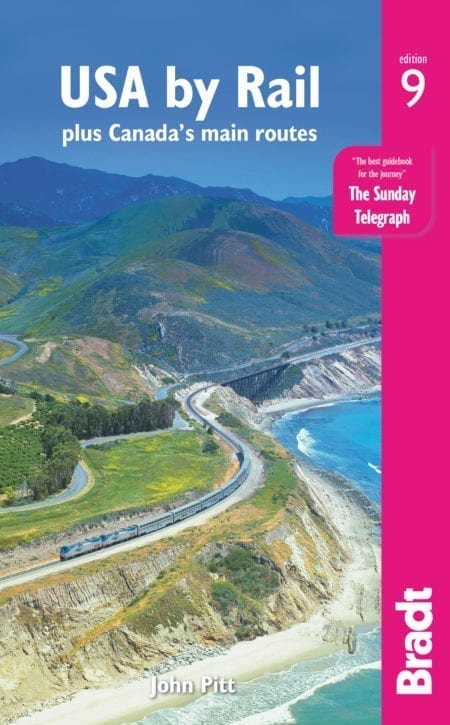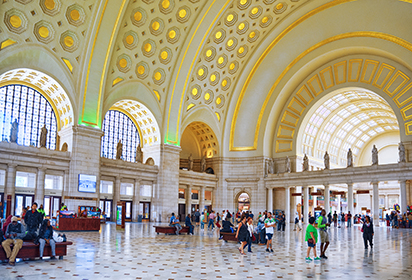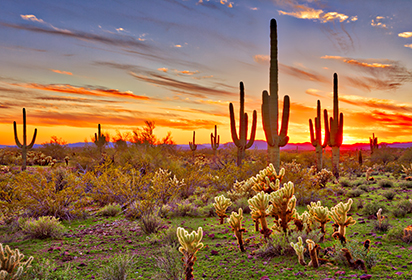America is a diverse country almost 3,000 miles wide so there is plenty of choice where to go on your trip, and a holiday to this diverse nation is always memorable.
John Pitt, author of USA By Rail: the Bradt Guide
You can travel through stunning landscapes from the primeval-looking Joshua trees of the Mojave Desert to the saw-toothed peaks of the Rocky Mountains, the mile-deep Grand Canyon, and majestic Niagara Falls, or visit the pounding surf of Atlantic and Pacific coasts.
Adrenaline junkies can explore untamed scenery in 59 national parks or have fun in theme parks such as Disney World and Universal Studios.
Among more than 35,000 museums are historic monuments like the Statue Of Liberty and the ravishing Metropolitan Art Gallery in New York, and away from the headline attractions you can find your groove in laid-back small towns, travel down fabulous highways or take a trip on some of the greatest trains in the world, with glimpses into how it feels to be an American – just like in the movies.
For more information, check out our guide to USA by Rail
Food and drink in the USA
Food
Americans dine out more than most people so finding somewhere to eat is rarely a problem. New York City alone boasts 15,000 places, from unpretentious cafés and hamburger bars to some of the finest restaurants in the world. Fast-food staples such as hot dogs, burgers, pizzas, KFC and McDonald’s are sure to make you feel at home, although American versions are likely to be superior.
You may be lucky enough to find one of the few remaining 1940s-style diners. An authentic place should have chrome fittings, a jukebox, ornate mirrors, counter seats and booths. Like coffee shops, diners are great for sampling the traditional American breakfast of eggs (cooked your way), crispy bacon, pancakes (with maple syrup), sausage, buttered toast and hash browns (fried grated potato), all washed down with coffee, tea (for the adventurous) or the ubiquitous Pepsi or Coca-Cola. Some places serve breakfast 24 hours a day.
Desserts are a major temptation, from homemade apple pie to chocolate fudge. No country has fancier doughnuts or better Danish pastries, not to mention chocolate-covered, peanut-filled pretzel nugget ice cream. Other ice cream varieties you may meet include garlic, lobster and many more.
America’s diverse population produces a formidable range of cuisines. Some of the world’s best Chinese food can be found in the Chinatowns of cities such as San Francisco and Los Angeles. You can sample black-eyed peas and grits in the south, steaks in Texas, and lobster, crabs or clam chowder in New England. Chicago invented the deep-pan pizza and in New Orleans eating is a way of life.
Some restaurants offer all-you-can-eat for a fixed charge or have two-for-theprice- of-one deals. Lunch is usually better value than dinner, but look for earlybird specials where evening meals are discounted until 17.00–18.00. Mexican food is tasty and cheap and salad bars, delis and supermarkets provide the basis for an inexpensive picnic. Sandwich bars sell any filling or bread you can think of, including the famous bagels with cream cheese.
Drink
The water is safe to drink and Americans prefer it iced. If a glass is not delivered with your meal you only have to ask. Any soft drink is a soda. Pepsi and Coke come in small, medium (meaning large) and large (meaning gigantic) sizes. Sprite and 7-Up may be familiar but root beer is definitely an acquired taste.
Bars range from the seedy to the glamorous and from cheerful to film-noir gloomy. The clientele may consist of businessmen, sports fans, LGBTs, singles, television addicts or any other all-American type. Look for cut-price drinks during happy hour, which sometimes stretches much further than 60 minutes. Arrive looking respectable between 17.00 and 19.00 and you can often fill up on free hors d’oeuvres as you sample a margarita or mint julep.
Drinks served ‘on the rocks’ have ice added while those ‘straight up’ do not. If you fail to specify you will usually get the ice. Measures are generous and spirits often 90° proof (45% vol), so don’t underestimate your consumption. Draught, canned and bottled beer will most likely be served well chilled, with brands such as Budweiser familiar to many non-Americans. Canadian or Mexican brands can also often be found. Various low-alcohol and alcohol-free ‘Lite’ beers are widely available. Groups can save money by ordering draught beer in a (usually half-gallon/2-litre) jug or pitcher. American wines, especially those from California, can be excellent.
Some states, including Utah, have laws restricting the sale of alcohol in various ways or in certain areas. The minimum legal age for the purchase of alcohol is 21, so if you look young enough you may be asked for identification. It is an offence in most cities to consume alcohol in a public place.
When to visit the USA
Most people choose summer, when days are warmer and longer and most of the attractions will be open, but this can create problems. Hotels are more expensive, restaurants more crowded and train reservations harder to come by. Large numbers of people, many as foreign as yourself, crowd around the very things you have come to see, and sometimes it can be too hot for comfort. Usually the weather is fine, though, and it can be exciting to travel when half the country seems on the move. Train reservations, flights and accommodation are more readily available in winter, often at reduced prices. You see fewer tourists and more of the real America, with only an hour’s wait for the Washington Monument elevator. The sun still often shines, at least in the South, and the skiing season is open. Landscapes, especially the Rocky Mountains, can look even more spectacular when sprinkled with snow. For many people, spring and autumn (known as ‘fall’ to Americans) are probably the best times to visit. During spring, flowers bloom in the mountains and the countryside is at its greenest. New England’s forests always put on a dazzling show for autumn ‘peepers’.
Travel and visas in the USA
Visas
Travellers to the US should have a full passport valid for at least six months after the intended date of return, although the US has an agreement with most countries, including the UK, automatically to extend the validity of a passport for six months past its expiration date. A British passport therefore needs to be valid only for the duration of your stay. Passport information (for the UK) is available on the website gov.uk.
Before you travel you should complete an online pre-registration form on the Electronic System for Travel Authorisation (ESTA) website. (Note that not all citizens qualify for ESTA; search online for the ‘ESTA eligibility checker’ to see if you do.) The US Customs and Border Patrol recommends that you do this at least 72 hours before departure. Applying for and securing an ESTA is a separate process to providing your airline with advance passenger information (details of your passport, country of residence, address of your first night’s accommodation in the US, etc). For more information visit the official ESTA website (see above). Beware of fraudulent unauthorised websites which charge you for information about ESTAs and for submitting ESTA applications to the Department of Homeland Security (DHS) on your behalf.
Getting there and away
Competition has reduced the cost of flights, particularly over the North Atlantic, but fares vary tremendously according to date and season. Low season generally runs from November to March, excluding Christmas. Midweek flights tend to be cheaper and it usually pays to fly into a gateway airport such as Boston, Los Angeles or New York (John F Kennedy and Newark), though places such as Cincinnati, served by Delta and Charlotte, served by British Airways are worth considering. The main airlines flying from Europe include American, United Airlines and Virgin Atlantic. Air India, El Al and Kuwait Airlines may be cheaper to book through agents such as Trailfinders in the UK.
What to see and do in the USA
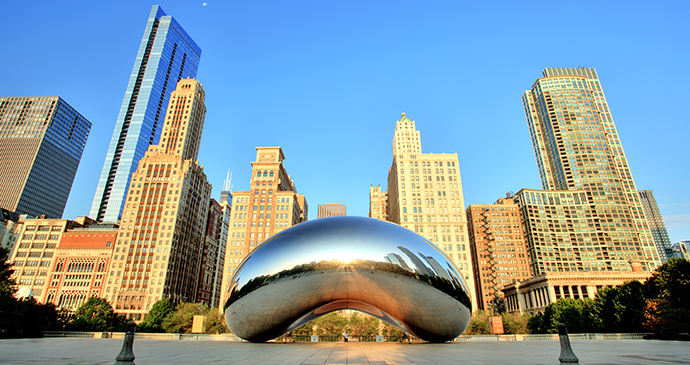
Chicago
The proclaimed capital of America’s third coast is one of the country’s largest and most ethnically diverse cities. Writers such as Saul Bellow, Nelson Algren and Sara Paretsky have lived in ‘the city of big shoulders’, as have Al Capone (gangster) and Mother Cabrini (first American saint). Poet Carl Sandburg called Chicago the ‘Player with Railroads and the Nation’s Freight Handler’. Harrison Ford and Raymond Chandler, whose father was a railway engineer, were born here, and Ernest Hemingway grew up in the middle-class suburb of Oak Park. Muddy Waters, Howlin’ Wolf and John Lee Hooker made blues history on the South Side.
Chicago began in 1833 but stayed a village until railways connected it to the east coast in 1852. Destroyed by fire in 1871 soon after the rail link with San Francisco was completed, the city rebuilt itself as a centre for industry, finance and the arts. The Junction Railway’s stockyards were where cowboys brought their cattle, and although these closed down long ago, Chicago retains a hard-headed commercial spirit. More mainstream and less pretentious than New York or Los Angeles, the city became the fashionable home of television’s ER and Oprah.
The first 11-storey skyscrapers were erected here, leading to the Chicago School of Architecture and subsequently Frank Lloyd Wright and Mies van der Rohe. You can see three of the world’s ten tallest buildings and superb architecture in every modern style, as well as outdoor sculpture, an elevated railway and the brooding Chicago River. Chicago boasts 29 miles (46km) of beaches but it can be bitingly cold in winter, when ice sometimes floats on Lake Michigan.
Recommended sights
Willis Tower
This building, completed in 1973, was the world’s tallest for 25 years, reaching 110 storeys and 1,454ft/443m (1,729ft/527m including added antennae). Ear-popping elevators shoot you to the 103rd-floor Skydeck for views of the city, Lake Michigan and four states. Go before sunset and watch the city come alight.
360 Chicago
Even at 327ft (99.6m) lower than the Willis Tower, the John Hancock Center observation deck gives wonderful views of Lake Michigan and the city. The 94th-floor observatory is more than 1,000ft (300m) above Chicago & features an outside Skywalk, a virtual-reality tour of more than 80 city sites, 3D ‘talking’ telescopes and a Chicago history wall. TILT , ‘Chicago’s highest thrill ride’, extends out and over the city’s famous skyline to give unique, downward-facing views.
John Shedd Aquarium
When the aquarium began in 1927, live specimens were transported here aboard a specially built fish car, the Nautilus, later replaced by the Nautilus II (now on display in the Railway Museum at Monticello, Illinois). Today’s splendid building holds 32,000 animals, including thousands of fish as well as the largest indoor collection of marine mammals in the world, such as beluga whales, seals, sea otters and dolphins. Don’t miss the penguins and the amazing alligator snapping turtle.
Navy Pier
A city landmark with 50 acres (20ha) of parks, gardens, shops, restaurants & attractions, including a Ferris wheel, carousel, children’s museum and Chicago’s Shakespeare Theatre. The 3,000ft pier (914m) was one of several planned for the city but the only one actually to be constructed (in 1916).
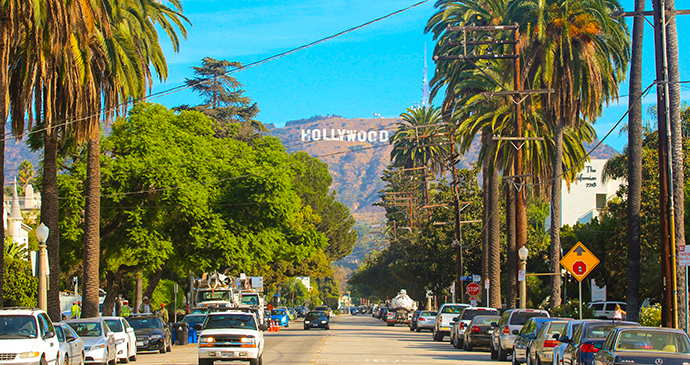
Los Angeles
Palm trees, beaches, blondes, surfing, freeways, smog and David Hockney swimming pools: Los Angeles is a sprawling place with an atmosphere all of its own. Founded by the Spanish in the 18th century as El Pueblo de Nuestra Señora de la Reina de Los Ángeles (the City of Our Lady, Queen of the Angels) its name grew shorter as the town became bigger. Completion of the transcontinental railroad in 1869, together with oil, Hollywood and a near-perfect climate, brought millions of settlers in search of the good life. America’s second-largest city now spreads ten million people over an area as big as Rhode Island and true Angelinos would never live anywhere else. The sun really does shine 90% of the year, although smog can be a problem in summer.
Recommended sights
El Pueblo de Los Angeles State Park
Los Angeles began here in 1781 and the city’s oldest house, the Avila Adobe, which dates from 1818, is at 10 E Olvera. This street also features Mexican restaurants and cheerfully tacky souvenir shops. Look also for the Masonic Hall (1858), Old Plaza Church (1822), Old Plaza Firehouse (1884) and Sepulveda House (1884). Free film and walking tours from the visitor centre.
Universal Studios
The second-biggest tourist attraction in southern California has spectacular rides such as Jurassic Park, King Kong in 3D and the Simpsons Ride, with character voices performed by stars of the TV show. You can enter the world of Shrek & experience the chilling, machine-controlled future with the Terminator, as well as The Wizarding World of Harry Potter with its Forbidden Journey and Flight of the Hippogriff.
National History Museum
Two world-famous habitat halls show African and North American mammals in their natural environments, and the museum is home to Megamouth, the world’s rarest shark. The Lando Hall of California History has fascinating exhibits showing the Southwest from the 1500s through to downtown Los Angeles in 1940.
J Paul Getty Center
With panoramic views of Los Angeles and the Pacific Ocean, the museum has 54 galleries to display one of the richest collections in the world, including medieval manuscripts and 65,000 photographs, as well as paintings by Cézanne, Goya, Leonardo, Michelangelo, Monet, Titian, Turner and Van Gogh.
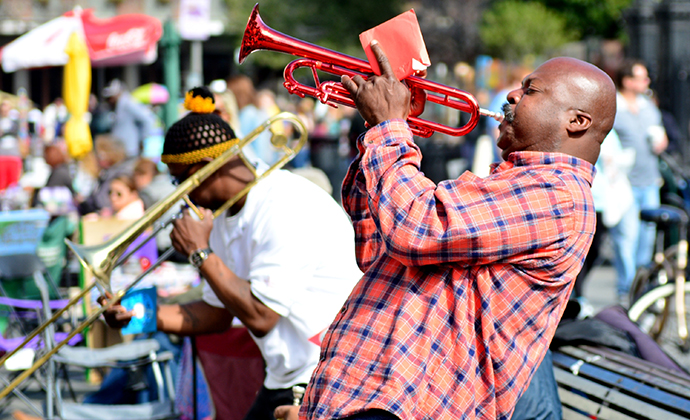
New Orleans
The ‘Big Easy’ features jazz, blues, Mardi Gras, voodoo and creole cooking, and more churches per person than anywhere else in the country. Immortalised by Tennessee Williams and William Faulkner, New Orleans was founded by the French in 1718, taken over by the Spanish, then bought by the US for $15 million in 1803. Settlers from France, Spain, Britain, Germany and the Caribbean have given it a uniquely cosmopolitan atmosphere.
Relaxed charm and a ragged beauty make New Orleans the perfect place for letting les bons temps roll. Apart from Las Vegas, this is one of the few places in America without a closing-time law. Louis Armstrong and Fats Domino were born here and blues, soul and Cajun music are played in hundreds of music clubs. Jazz venues include Mahogany Hall at 309 Bourbon Street and Preservation Hall at 726 St Peter.
The effect of Hurricane Katrina on New Orleans in August 2005 was catastrophic because of the failure of the levees that should have protected the city. Over 200,000 properties were damaged or destroyed by the floodwaters and more than 1,500 people died. Reconstruction and recovery work still continues in some areas, especially the Ninth Ward that was worst affected. Despite this, the most celebrated and historic parts of the city, including the French Quarter, Garden District and St Charles Avenue, remain intact and are thriving.
Recommended sights
French Quarter
The Vieux Carré (Old Square) centres on Jackson Square, where the first settlers arrived in 1718. The finely decorated wrought iron on the houses was made in Birmingham, England. You can soak up the atmosphere best at the French Market and along Bourbon Street.
Jackson Square
Originally the Place d’Armes, where soldiers marched and public executions took place. Later it became a park and was renamed after General Andrew Jackson, whose statue stands opposite the cathedral. See artists, street musicians and entertainers free and have your future told by tarot cards.
The Cabildo
This was the site of the Louisiana Purchase Transfer and was built between 1795 and 1799 as the seat of the Spanish city council in New Orleans. The building has also served as the Louisiana Supreme Court and became part of the Louisiana State Museum in 1911. Reopened in 1994 after being damaged by fire, the Cabildo focuses on Louisiana’s early history.
Mardi Gras
The greatest free show on earth takes place during the month before Lent, with parades, bands and every kind of revelry. Book your accommodation in good time. Mardi Gras World has a collection that includes thousands of carnival props and giant figures.
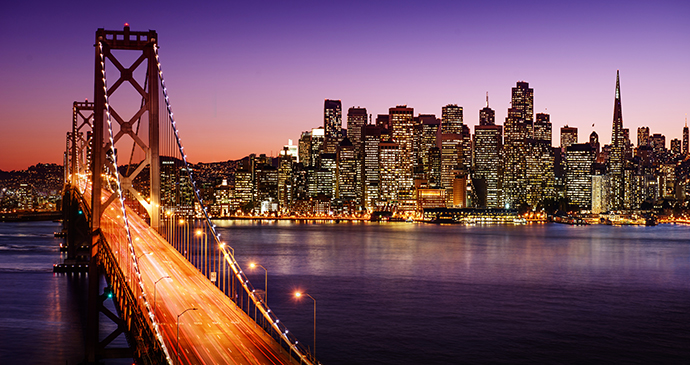
San Francisco
The ‘City by the bay’ is famous for its Golden Gate Bridge, fog in the morning, vertiginous streets, elegant houses and Alcatraz. Home of Dashiell Hammett and Sam Spade, San Francisco was the birthplace of beatniks, hippies and the topless bar. Finance, industry and a large LGBT community coexist in the cosmopolitan atmosphere. With ‘Silicon Valley’ to the south, the city has become home to some of the world’s most successful dot.com companies, creating hundreds of 25-year-old millionaires. Spaniards arrived here in 1776 but the city prospered only after it became a part of the United States. When gold was discovered in 1848, ships and wagon trains, then the railroads, began bringing thousands of settlers across the Sierra Nevada. San Francisco’s Chinatown was founded (like the one in Vancouver, Canada) by immigrants who worked on the transcontinental railroad. Neither the 1906 earthquake nor the tremors of 1989 and more recently have dissuaded a million people from making the city their home.
Recommended sights
The Golden Gate Bridge
Linking the city with Marin County to the North is one of the world’s best-known and most impressive landmarks. At 2 miles (3.2km) long – 7 miles (11km) including approaches – it incorporates 80,000 miles (128,000km) of cable and is painted orange rather than gold. Magical views of San Francisco from the Marin County side.
San Francisco Museum of Modern Art
One of the largest contemporary art museums in the world, San Francisco’s Museum of Modern Art (SFMOMA) contains more than 33,000 modern works, including paintings by Henri Matisse, Georges Braque, Jackson Pollock, Marcel Duchamp, Frida Kahlo, Edward Hopper, Francis Bacon and Andy Warhol, as well as photographs by Ansel Adams.
Fisherman’s Wharf
On the waterfront between Taylor and the Embarcadero, the wharf has gift shops, salt air, cruise boats and hordes of tourists. Open-air stalls sell freshly cooked seafood while sea lions bark for fish and gulls glide above the water. Downmarket pleasures include a wax museum, the Guinness World of Records and Ripley’s ‘Believe It Or Not!’.
The Cannery
Built in 1894 as a fruit-canning factory, the Cannery has been converted into a mall with dozens of shops, a comedy club, restaurants and art galleries. Jack’s Cannery Bar boasts more beers on tap than almost anywhere in the country. There are stalls and cafés among century-old olive trees in the courtyard and street performers entertain on summer weekends.
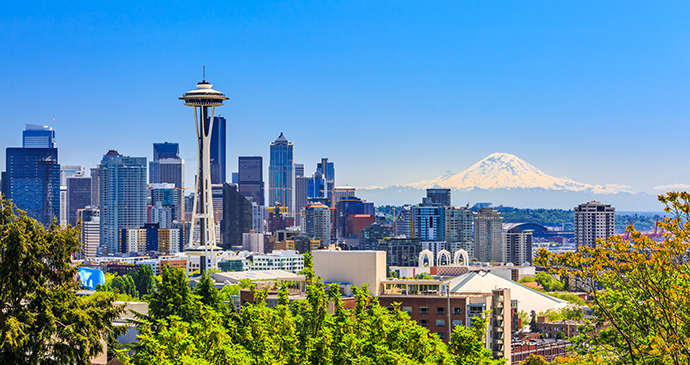
Seattle
Surrounded by mountains, Lake Washington and Puget Sound, the Emerald City was named after Chief Sealth of the Damish and Suquamish tribes. Seattle sees only 56 days of sun a year but has less rainfall than New York or Atlanta, so the city is not quite so wet as outsiders may imagine. Water provides an important leisure resource, however, and countless marinas provide enough space for two boats to every three people.
Seattle was the birthplace of Jimi Hendrix (buried in Greenwood Cemetery in the suburb of Renton), Starbucks coffee, grunge rock and Microsoft. Lately one of America’s most fashionable cities, famous for its coffee houses, Seattle has been the setting for movies such as The Fabulous Baker Boys, Sleepless in Seattle, Captain Fantastic, Get Carter and Battle in Seattle, as well as television’s Frasier. A monthlong film festival is held each spring and the Folklife music festival takes place around Memorial Day.
Recommended sights
Seattle Center
This legacy of the 1962 World’s Fair, a min or so from downtown by monorail, has over 70 acres (28ha) of parkland and entertainments, dominated by the 605ft (198m) Space Needle. Take an elevator to the observation deck for lofty views of the city, Puget Sound and Mount Rainier.
The Waterfront
Where gold arrived during the 1897 Klondike rush, ex-Australian streetcars now run along waterfront tracks. Ferries to Canada and Alaska go from Pier 48, and to Bremerton and Bainbridge Island from Pier 52 (Colman Dock), giving wealthy island commuters inspiring views of snowcapped mountains and an occasional whale.
Pike Place Market
This 1907 market is a warren of shops, restaurants, galleries and stalls selling every kind of fish, fruit and vegetable. Great for street entertainment, people-watching and dodging the flying salmon.
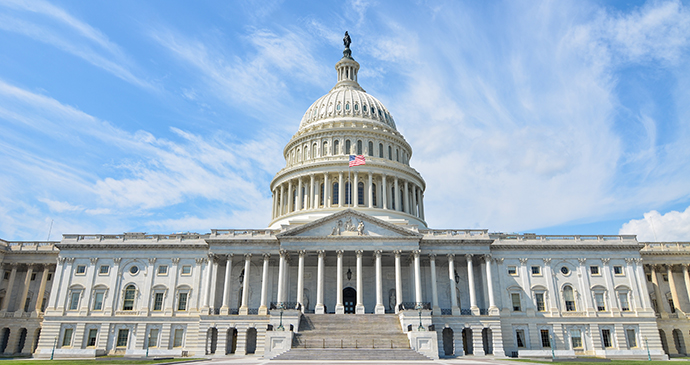
Washington, DC
‘Southern efficiency and northern charm’ was President Kennedy’s mischievous description of Washington, DC, an elegant Neoclassical city designed by Pierre Charles L’Enfant on what had been a swamp. The architecture, boulevards and green spaces provide a fine setting for Washington, DC’s main business – government. Events include the cherry blossom festival in April and an Independence Day parade in July. Tourist areas are clean and impressive but the nation’s capital has a darker side. Drugs and other crime make parts of the city unsafe, so stay on the beaten track. Summer can be oppressively humid.
Recommended sights
The White House
This official residence has been occupied by every US president since George Washington. Tours (for US citizens) can be arranged by contacting your Member of Congress and reservations must be confirmed at least one month in advance. Visits by non-US citizens must be made through their embassies in Washington, DC.
The Capitol
The nation’s most important building was completed in 1800, when the Senate and House of Representatives met in joint session on 22 November. The familiar white dome is a later addition. In addition to its use by Congress, the Capitol is a museum of American art and history.
The Washington Monument
The tallest (555ft/170m) structure in the city and the highest free-standing masonry edifice in the world. A line in the marble a quarter of the way up shows where building work stopped during the Civil War. Finally completed in 1888, the monument provides stunning views from narrow slits in the observation deck.
Lincoln Memorial
A classical Greek-style temple overlooks a reflecting pool. The walls around Abraham Lincoln’s 19ft (5.8m) statue are inscribed with the words of his Gettysburg Address. Appropriately, this is where Martin Luther King made his ‘I have a dream’ speech.
Related books
For more information, see our guide to USA by Rail:
Related articles
These US railway stations are more than just transport hubs.
Heading through dramatic canyons and vast barren landscapes, these are the best desert railways in the USA.
